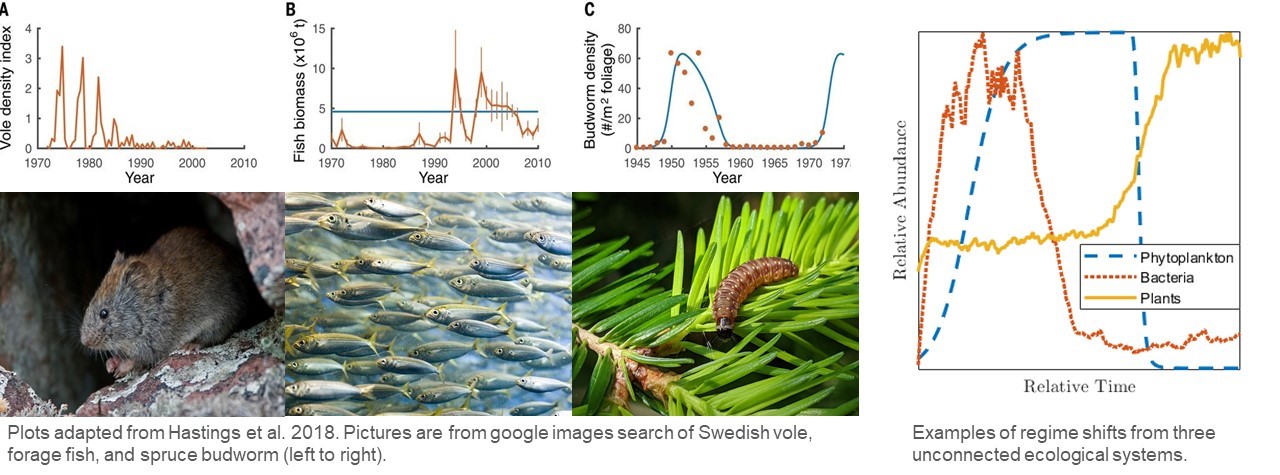Mathematical biology
Mathematical Biology is a multi-disciplinary research program lying at the interface between mathematics and biology. It entails the development and rigorous analysis of mathematical models for gaining qualitative and quantitative insight into biological phenomena and processes, such as cellular biology, ecology, epidemiology, evolution, immunology, neurophysiology, etc.
Research faculty members in this area
Learn more
Mathematical biology
Part of the mathematical biology research program at the University of Manitoba focuses on the design and analysis of models for the spread and control of emerging and re-emerging diseases of public health importance. Some work concerns childhood disease, focusing on the mathematics of imperfect vaccines and understanding the distinct epidemiological signatures of different modes of vaccine failure. Infectious disease modelling involves a combination of theoretical analysis, numerical experimentation and modern statistical inference techniques.
Another area of research concerns the worldwide spatiotemporal spread of infectious pathogens in relation to travel, with an emphasis on providing an advanced warning to public health officials regarding infectious disease risks. The objective of the epidemiology research program is to contribute to the development of effective public health policy for combating the spread of diseases.
Another active research program is in the area of cellular biology, and more specifically, cytoskeletal networks, which are protein networks within cells. The organization of a cytoskeletal network is the main determinant of its cellular function. Specific interests include models of the organization of networks and the assembly of filaments composing those networks to characterize the determinants of their structures and mechanical properties. The research involves a tight collaboration with experimentalists, mathematical conclusions and model responses are calibrated and validated by comparison to experimental data. The objective of the cytoskeletal research program is to contribute to the understanding of the structure and function of the cytoskeleton in cells.
Additionally to the traditional outcomes available to mathematics students, mathematical biology students can find jobs in regional, national and international public health agencies, environmental agencies, pharmaceutical companies, etc. In particular, graduates of our mathematical biology program are accepted for PhD programs at top universities and have won prestigious doctoral and postdoctoral fellowships; some hold tenure-track positions in universities around the world and others work in local public health agencies.
Biomolecular interactions
DNA and RNA molecules store the genetic information of an organism and play fundamental roles in many biological processes. Current research consists of developing and utilizing combinatorial methods to tackle questions about the interactions and arrangement of DNA and RNA in biomolecular complexes; for example within R-loops, multi-stranded structures made of a DNA-RNA complex and a free DNA strand. This area of research typically involves mathematical modelling, computer programming, and data analysis of experimental data. In addition, it often requires blending approaches from different branches of mathematics, such as combinatorics and knot theory, as well as collaborations with experimentalists in biosciences.
Cellular signalling
I have been using interdisciplinary approaches to solve questions in cellular signalling. I combined mathematical analysis and computation of differential equations (DDE, ODE, and PDE) to investigate the dynamics in morphology, cancer immunotherapy, and G protein signalling in plant cells. I also work closely with biologists and wet lab experimentalists to create mathematical models that can capture and predict real phenomena to help experimental design. In morphology, I investigate the mechanisms of Notch signalling in segmentation via interdisciplinary approaches to overcome technological limitations and discover the fundamental mechanisms of signal transmission and pattern formation in segmentation. In cancer modelling, I focus on immunotherapy. I constructed PDE models to fit the tumour growth data, provided hypotheses, and developed efficient therapeutic protocols. For G protein signalling, I perform experiments on plant cells and use fluorescence microscopy to capture the behaviour of proteins. Based on the data that I collected and analyzed, I constructed mathematical models by machine learning methods to discover the mechanism of G protein signalling. I further designed and performed experiments to verify my model predictions.
Ecological dynamics
Mathematics offers a powerful lens for understanding and predicting dynamics in ecological systems. In particular, we aim to uncover mechanisms that drive qualitative changes in populations. While mathematical models have readily been used to study long-term outcomes of ecological systems, such as persistence and extinction, fewer tools exist to study the short-term dynamics. Yet, many ecological issues arise from complex changes occurring over relatively short but ecologically relevant timescales. These changes in biological regimes can occur in response to changing environmental conditions or due to intrinsic system processes in the absence of changing external factors and lead to the study of tipping points and transient dynamics. Understanding these regime shifts is particularly relevant to helping address pressing ecological issues, such as sustainability, climate change, and the effects of myriad anthropogenic disturbances. Moreover, predicting such shifts in real ecological systems is pivotal for managing sensitive ecosystems. As such, collaborations with field ecologists are an important component of this research. Currently, we focus on phytoplankton dynamics and anaerobic digestors. However, our methods and theories – including dynamical systems, machine learning, data science, and computation – are broadly applicable to many different species and systems. The included images show both mathematical and empirical examples of ecological dynamics we may study.
Understanding these regime shifts is particularly relevant to helping address pressing ecological issues, such as sustainability, climate change, and the effects of myriad anthropogenic disturbances. Moreover, predicting such shifts in real ecological systems is pivotal for managing sensitive ecosystems. As such, collaborations with field ecologists are an important component of this research. Currently, we focus on phytoplankton dynamics and anaerobic digestors. However, our methods and theories – including dynamical systems, machine learning, data science, and computation – are broadly applicable to many different species and systems. The included images show both mathematical and empirical examples of ecological dynamics we may study.
